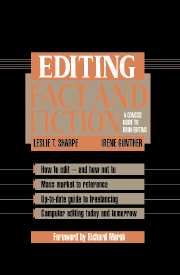Book contents
- Frontmatter
- Contents
- Foreword
- Acknowledgments
- Introduction
- Chapter 1 Who (and What) Is an Editor?
- Chapter 2 Fact or Fiction? Finding Your Niche
- Chapter 3 Principles to Edit By
- Chapter 4 The Editor's Senses
- Chapter 5 The Editor's Sensibility
- Chapter 6 A Guide to Editorial Freelancing
- Chapter 7 Electronic Editing Today and Tomorrow
- Chapter 8 Tools of the Trade and How to Use Them
- Index
Chapter 1 - Who (and What) Is an Editor?
Published online by Cambridge University Press: 21 September 2009
- Frontmatter
- Contents
- Foreword
- Acknowledgments
- Introduction
- Chapter 1 Who (and What) Is an Editor?
- Chapter 2 Fact or Fiction? Finding Your Niche
- Chapter 3 Principles to Edit By
- Chapter 4 The Editor's Senses
- Chapter 5 The Editor's Sensibility
- Chapter 6 A Guide to Editorial Freelancing
- Chapter 7 Electronic Editing Today and Tomorrow
- Chapter 8 Tools of the Trade and How to Use Them
- Index
Summary
To many people embarking on a career, as well as to those in the general public with a love of books and reading, publishing has a special mystique. And the job of editor is held in high prestige.
It is also cloaked in mystery. What is an editor? What does he or she do? Even publishing insiders find it hard to answer those questions because the title “editor” is a catch-all that includes a multitude of jobs and functions. Acquiring editor, managing editor, line editor, copyeditor, production editor–these are just a few of the confusing species.
What do those who share the title of editor have in common? What distinguishes one from the other? The simple answer is that all of them deal with words, but they do so in different ways and to varying degrees. Some editors deal with broad concepts, others see to it that commas and hyphens are in the right place, still others are concerned with how the words will appear on the printed page. Let us go into an editorial department and take a closer look at some of the species.
Classifying the Species
Acquiring Editor
The acquiring editor is the person most people have in mind when they hear the word “editor.” (He or she is also known as senior acquisitions, general, or senior editor or, if the head of a department, as editorial director. For the sake of simplicity, we will refer to this editor either as acquiring or senior editor.)
- Type
- Chapter
- Information
- Editing Fact and FictionA Concise Guide to Book Editing, pp. 8 - 30Publisher: Cambridge University PressPrint publication year: 1994



